In a clearing rain and soft mist LITTLE JOY slid through calm water to the middle of the Mississippi River, about 2 miles below Lock and Dam #1 in Minneapolis, the highest navigable on the Mississippi River. The river, here at Hidden Falls, is only 100 yards wide, clear and cold, with a gentle but steady flow. With a smile for my wife Xiaole, who was seated comfortably in the stern, I put my back into it, rowed out to mid-river, and caught the current that flows south to the Gulf of Mexico.
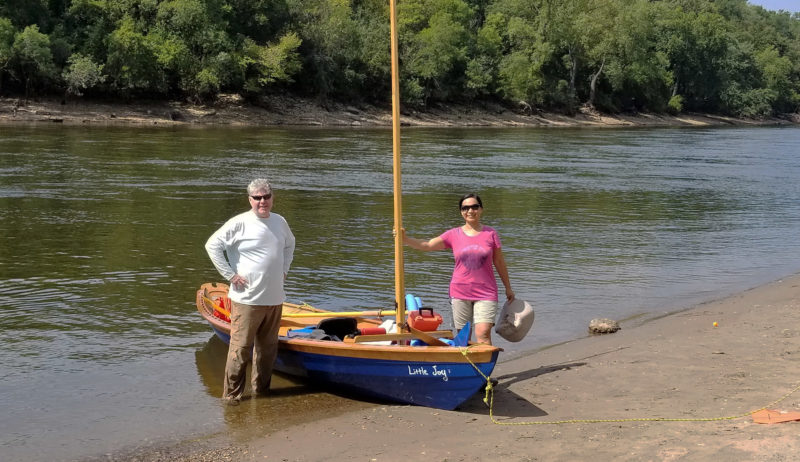 Photographs by Xiaole and David Hudson
Photographs by Xiaole and David HudsonAfter a 1,100 mile road trip from Philadelphia, we put in a Hidden Falls Park on the southern fringe of Minneapolis. The river was hardly looking like the Mighty Mississippi I’d imagined.
Our plan, well my plan, was to row/sail down the entire 1,800 miles of the Mississippi River in a 17′ dory I built in my backyard. Xiaole (pronounced Shihow-luh) wore a bulky, bright orange PFD. She is not the strongest swimmer, and we debated whether she should even come along. We eventually settled on having her come along for just the first week.
After just 3 miles of rowing, the tall office buildings of St. Paul appeared around a bend in the river, rising right along the eastern bank. Steel barges, 35′ wide and 200′ long, were tied on both sides of the river. A towboat just as big, with twin exhaust stacks and a square bow, idled next to them.
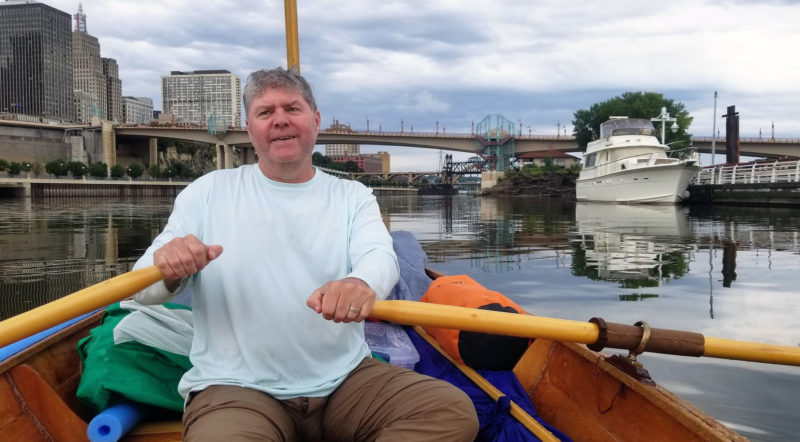
As we approached the first of the four bridges in downtown St. Paul, the river was quiet and we were at ease. Beyond the fourth bridge, the traffic of tows and barges would demand our close attention.
We moved with caution and worked our way past the barges and towboat. Two narrow channels ran underneath two successive bridges. A towboat underway now and pushing two barges passed us in the left channel. More barges and towboats slipped by as we put downtown St. Paul behind us.
Downstream from the city, the banks became heavily tree lined, and we made our way between small wooded islands and past the mouths of numerous back channels. A pair of bald eagles, perched high on a leafless tree, peered down on us. This was more like it, but what wasn’t more like it were the pleasure boats. It was Labor Day Sunday and they were out in force, enjoying the last weekend of summer. There were cruisers and houseboats, pontoon boats and jet skis, and even some I would call yachts. The one thing they had in common were motors and speed. Pulling with our oars at 3 mph, we felt we did not belong.
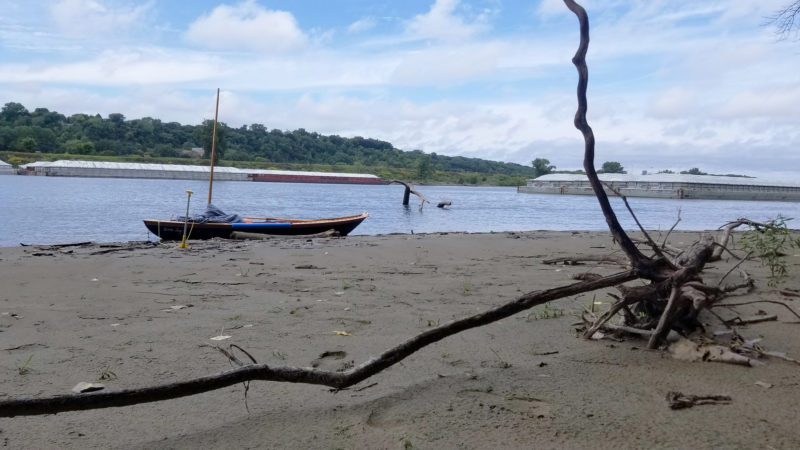
We took a break on a muddy beach just below St. Paul. This section of the river is quite narrow and crowded with tows.
Camping spots were plentiful among the islands and wooded shores, but unfortunately, the good ones were occupied with the pleasure boaters spending the night on the river. We finally managed to find a small grassy spot on a point of land, set up the tent, and eat some noodles with the last of the evening’s light. We had gone less than 22 miles on our first day, far less than I’d planned, but I was satisfied. We were off. Soon after we zipped the tent door shut, I fell asleep, exhausted.
We pushed off by 7 a.m. the next morning and rowed into a side channel warmed by the newly risen sun. The pleasure boaters were all still asleep and we had the river to ourselves. Several flocks of white pelicans flew low overhead, their white bodies bright against the blue sky. A turtle, balanced on a log, basked in the morning sun, then slid into the river as we drew near. An immature bald eagle, big but lacking the white head, flew past as another sat high in trees and surveyed the river.
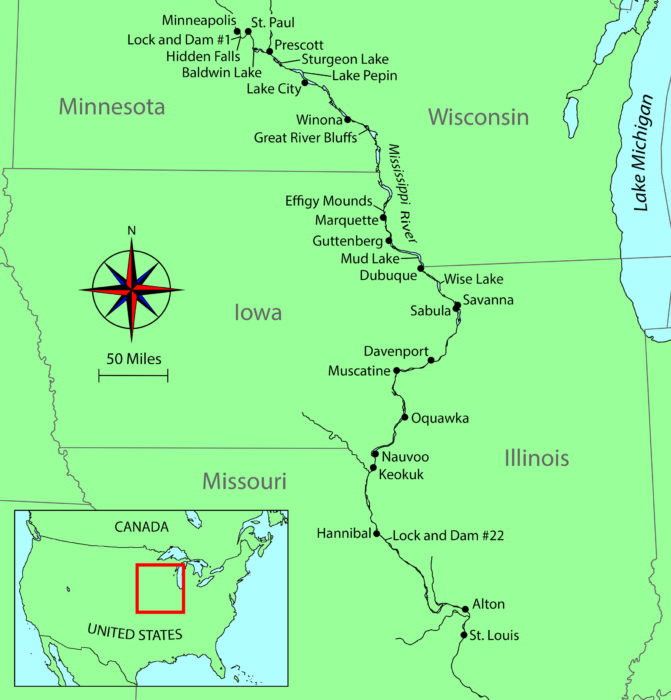 Roger Siebert
Roger Siebert.
We rejoined the main channel after passing through Baldwin Lake as the pleasure boaters began to wake up and head home. Roaring engines followed by 2′-high wakes would make me break my rowing rhythm. I would turn LITTLE JOY square to the waves and ride them out. Eventually, at the sound of the engines, my chest would tighten.
It rained on and off throughout the afternoon, but we made 35 miles and called it a day at Prescott, Wisconsin. Heavy rains were expected that night and through the next day so we left LITTLE JOY at a small marina, free of charge, and walked to the only motel in town. I was happy with the mileage, but I was exhausted and the motorboats added a new level of anxiety. “Are we too old for this?” I asked my wife. “We are not too old,” she said with a reassuring smile.
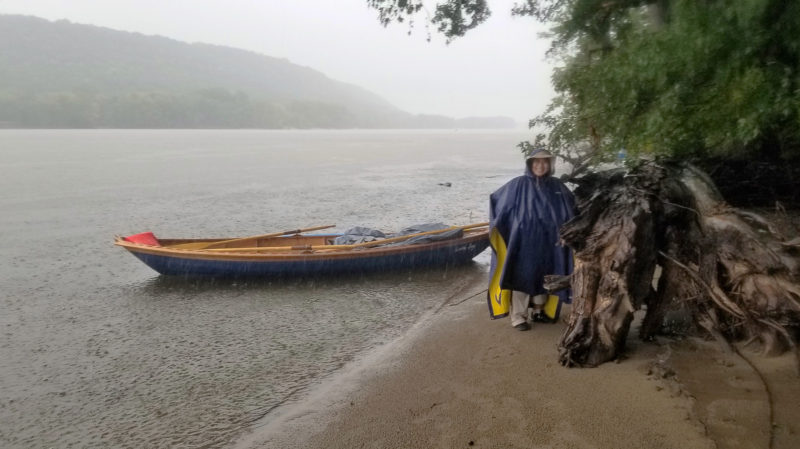
Not far from Prescott, Xiaole sought a little cover on a mid-river island during a violent summer storm. After the first three days, we encountered little rain.
The clouds were dark and heavy the next morning, and we set out in a light rain. We decided to make a run for a casino resort about 11 miles away. We could hole up there for the night when the storm came through. Right away the rains increased and got so heavy we pulled ashore and stood under the trees. A′’-long northern water snake slowly emerged from the trees, slinked onto the sand, and lay there near our feet.
We rowed off the river into Sturgeon Lake, tied up at the Casino marina, and spent the afternoon and night warm and dry in a hotel room as we watched the rain come down in torrents. It rained over 5” overnight and in the morning, the gear we left in LITTLE JOY floated in 8” of bilgewater. I started to bail.
The sky, now a brilliant blue, shimmered off the clear surface of the river. Still at the oars, my wife not yet ready to take a turn, I rowed easily down the middle of the river. There were no pleasure boats, no whining outboard motors. The Tuesday after Labor Day brought peace and quiet.
I enjoyed the warmth of the summer sun on my back and the company of my wife as we wound our way mile after mile downriver to Lake Pepin. At 20 miles long and 2 miles wide, it’s the largest lake on the river. The north wind that had brought clear skies was hard from the north, straight down the lake.
LITTLE JOY has a simple lug sail. I had sailed before: exactly three times, in light wind, and not competently.
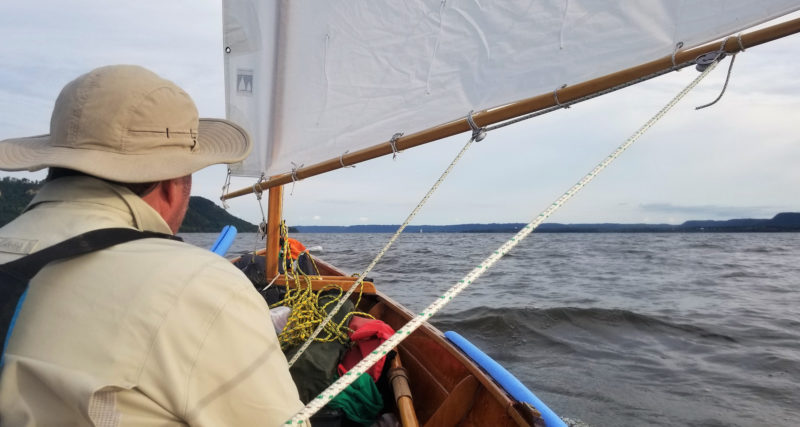
Lake Pepin was big enough to try a little sailing. It was fun, fast, and exciting. Unfortunately, I was new to sailing and my sailing skills weren’t up to the task. This was the first and only time I tried sailing on the river. The bluffs all around were a common sight from Minnesota down to Iowa.
I hoisted the sail and pulled in the mainsheet. Off we went straight down wind. I squatted low on the middle thwart and Xiaole hung on tight in the stern as we flew over choppy waves down the middle of the lake. With growing confidence but ample anxiety, I guided LITTLE JOY 10 miles and aimed for a small point of land jutting out just north of Lake City. I hit it perfectly…by which I mean I hit it. The rocky beach was being pounded by small waves and, combined with the strong wind, bashed my boat against the rocks. I got Xiaole out of the boat and safe on land.
The campground was actually a half mile upwind. I took the sail down and worked my way back by pulling the boat along the shore and by rowing. Hok-Si-La Campground was empty, and we set up camp protected from the wind by the trees lining the edge of the beach. The exposed sandstone of the 400’ bluffs on the far side of the lake glowed in the warm light of the setting sun. As the wind died down, Xiaole and I ate noodles and eggs and watched the stars come out over the lake.
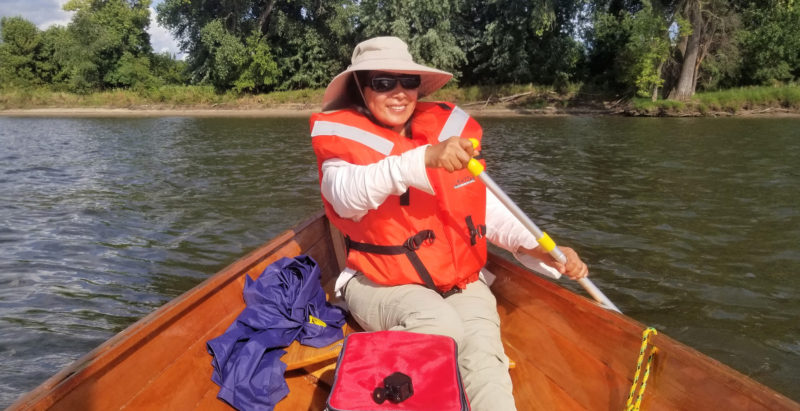
Xiaole used the paddle to contribute to our downriver progress. It wasn’t very effective so she didn’t use it often but enjoyed paddling when she did.
The next day we reached the south end of the lake, rowed along the 1/4-mile-wide river to Wabasha, and spent the night on a sandy beach 6 miles downstream from town.
The next day was leisurely, spent entirely on the river, covering 26 miles and ending camped on the tip of an island shaped like a crooked finger pointing upstream. We were on the river early the next day. Winona was just 3 miles away, and we left without breakfast.
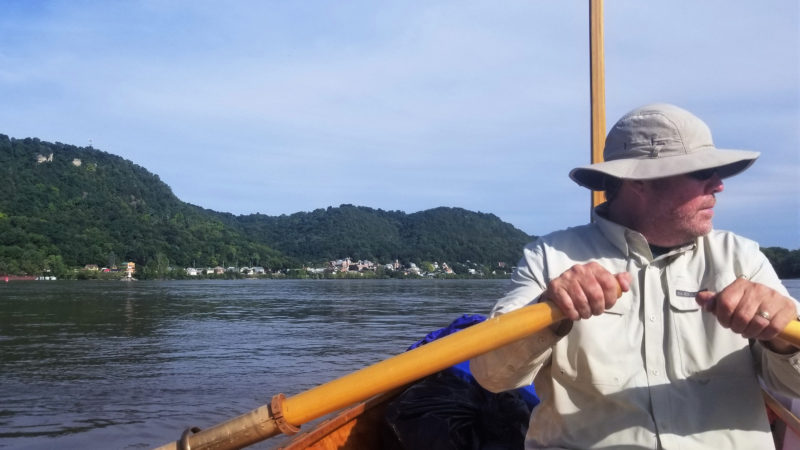
Five miles upriver from Winona, Fountain City is typical of many river towns, nestled under the bluffs and stretched out along the river.
The current was moving 3 mph as we approached Winona, so I rowed LITTLE JOY to the shore just upstream from the dock. Xiaole was ready with a line. Approaching the cement dock, I spun around and pointed the bow upstream as we got close. The current carried us past as Xiaole threw the line around an oversize steel cleat and tied us off.
As we set out for town, I had my heart set on pancakes. After a search of the main street, we came up empty. We settled for an artsy coffee house, and I had to content myself with an enormous cinnamon bun and a cup of coffee. After days of noodles and fried eggs gritty with sand, this would have to do.
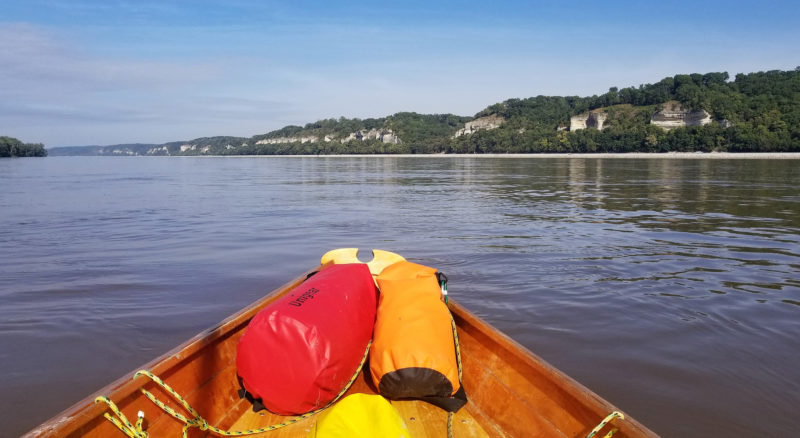
Great white cliffs begin at the confluence of the Illinois River and the Mississippi at Grafton, Illinois, and run 10 miles down toward Alton, Illinois. The Great River Road, a National Scenic Highway, was my companion on and off and runs right below the cliffs here.
Xiaole’s leg of the trip was over and she caught a bus to head back home. I walked back to the river alone. Fifteen miles downriver, I pulled ashore and made camp on an island directly across from Great River Bluffs State Park. Sitting alone on the sandy beach, I dined on fried chicken and cold iced tea from the resupply I did in Winona. Steep tree-covered bluffs rose before me topped by two 500’ peaks, the highest 200′ of each were sheer, exposed rock faces of dolomite. The cliffs run on both sides of the river, north and south, for dozens of miles; they closed in on the river as night fell.
Rising with the sun I stretched and let out a moan. My back was stiff. I’m 55 years old and a stiff lower back is nothing new. To add to that, four months ago, I separated a rib swinging a golf club and I wasn’t sure it was completely healed.
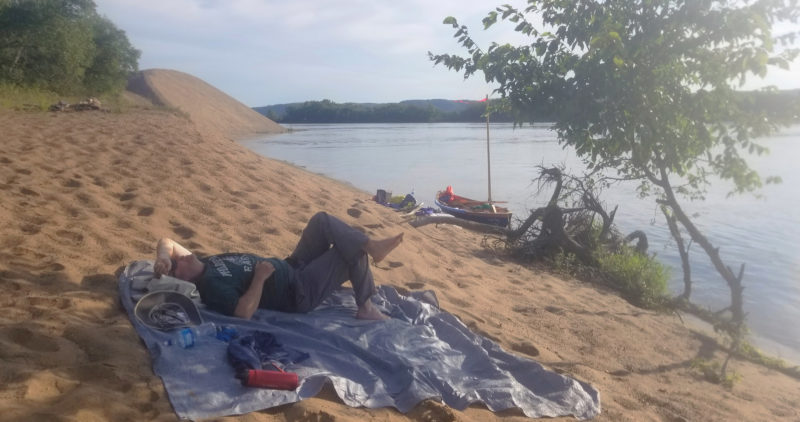
I took a break in a spot of shade to give my back a much-needed stretch. This beach was exceptional though not uncommon for a camping spot. Minnesota and Wisconsin both provide, free of charge, sandy open beaches for camping and day use. This would change as I got to the states farther south.
The two-man backpacking tent I set up on the beach is barely big enough for one person and a few overnight items, so I left most gear outside or on the boat. Packing up was easy except for the stooping to set up and tear down the tent—my back made it slow work.
I rowed in silence. With Xiaole gone, the aft seat was now empty, and beyond it is an expansive view of where I had just been.
I had rearranged the gear to trim the boat and stowed the sail away for good—the river was too dangerous for my sailing skills. I frequently looked over my shoulders, left then right, looking for obstacles. There were plenty. Fallen leaf-bare branches, uprooted stumps, and even entire trees floated past. Channel buoys, concrete channel markers, wing dams, river-wide dams, and bridges all stood immovable and the river wrapped around them.
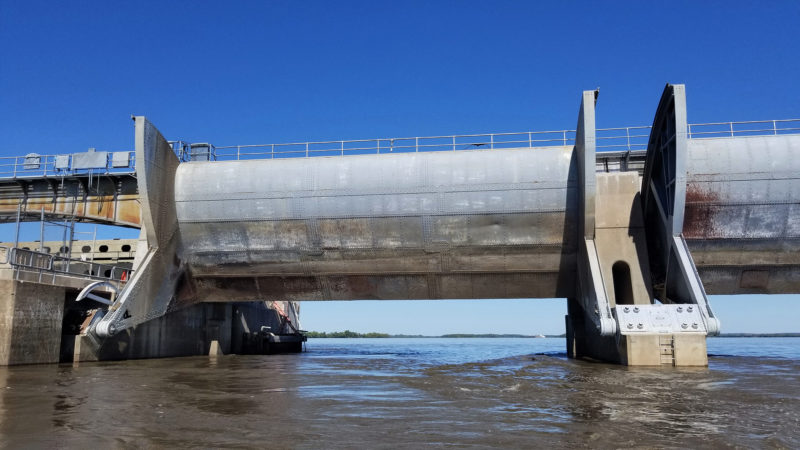
It was a dangerous game to play, but I passed through this spillway and underneath the massive pivoting gate. Looking upstream, as here, it is easy to see the drop to the downstream side of the dam, but when I approached a spillway from the upstream side it was hard to determine the water level on the far side. It could have been a dangerous 6’ drop. The water level was very high because of the heavy rains in the upper Midwest, so many dams had the gates raised to let the river flow through unimpeded.
I was lost in the routine, daydreaming, when Bang! I was thrown forward then back, whiplashed and jolted. A shamrock-green steel buoy, as round as an oil drum and rising higher than my head went by in slow motion, scraping along the gunwale. I quickly headed to shore to inspect the damage.
Other than a small dent on the bow and a long green paint smear on the port gunwale, LITTLE JOY was fine. I, however, grumbled to myself for allowing such a potentially dangerous thing to happen. The Mississippi River, starting at the Gulf of Mexico all the way up to Minneapolis, is dotted with hundreds of red and green channel markers. Looking over the stern I’d see the wake left by LITTLE JOY’s passage through the water, and it was easy to forget the water itself is moving. Buoys, while they’re fixed to the bottom, appear to be charging upriver like submarines with only their sails showing. I had hit one head on, but it felt like it had run into me.
I passed the Effigy Mounds National Monument, where hidden in the woods are earthen mounds in various animal forms built by native people in the first millennium.
After nine days on the river I’d traveled 172 river miles and crossed the border from Minnesota into Iowa. That was only on the right bank—I still had Wisconsin on the left bank—but still, it was reassurance that I was getting somewhere.
Marquette, Iowa, is a village of only a few hundred people that lies in the shadow of one of the 130 bridges that span the Mississippi. After rowing under the bridge, I pulled up to a floating wooden dock where I met a man with a bushy blond mustache, cargo shorts, and high-top work boots. He gave me dock space, a giant cup of coffee, and pointed me to a place I could finally get a pancake breakfast.
Back on the river, I had a view of the bridge that carries US-18 across the river. Its single powder-blue steel arch stretching high above the deck for the roadway blended in with the cloudless sky behind it. Beneath the bridge I got a glimpse of a tow heading downriver toward me.
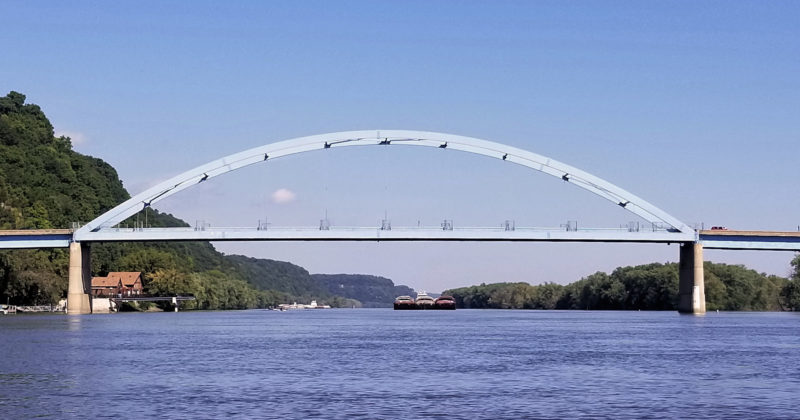
The bridges spanning the river come in many shapes and sizes and include many old, low railroad bridges that have a lift or a swing section that has to be moved to allow bigger boats to pass. This more modern highway bridge at Marquette is prettier than most. The tow seen here under the bridge would soon pass close by.
On the Upper Mississippi a “tow,” as it’s called, usually consists of a towboat and a set of barges, three abreast and five end-to-end that are cabled together into a rectangular raft. Each barge is 200′ by 35′, so a 15-barge tow with a 200′ towboat is 1,200′ long. I learned that the thousands of tons of cargo a tow carries is equivalent to a railroad train 3 miles long or a convoy of trucks 35 miles long.
The towboat, its two diesel engines whining, steered under the bridge close to the Iowa side following the marked channel. When it was a mile away, I moved tight to the Iowa shore knowing the tow would be back in the middle of the river when it passed. Ten yards from shore I sat and waited. The water along the shore was emerald green, covered by duckweed; round leaves no larger than 1/4″ floated on the surface in large mats, extending unbroken for hundreds of feet.
The bank at the river’s edge rose sharply about 10′ above me to a railroad. I heard a distant rumble and within minutes a freight train roared toward me. The engineer leaned out of the cab window of the red Canadian Pacific locomotive. Our eyes met and I waved. He gave me two short blasts of the horn as the train thundered by.
Just then the tow reached me, and its 100′-wide three-barge bow pushed the river out of its way with blunt brute force. I waved to the pilothouse high above the deck. No one waved back. I turned LITTLE JOY, moved away from the shore, and headed straight into the churning wake. LITTLE JOY rode over the waves with ease.
Tows passed me up to three times a day. They were going both upstream and down, and I kept an eye on the ones coming upstream, behind my back, even though once spotted there was plenty of time to get out of the way.
The next day I rowed 27 miles and stopped at a charmless county park at Mud Lake on the Iowa side of the river. I tied LITTLE JOY next to a concrete boat ramp. I stood, stretched my back and walked to a campsite under some large shade trees in easy view of the ramp. Still stiff from the day’s row, I hobbled around the end of an 8′ white panel fence separating the marina from the campground to see about keeping LITTLE JOY there for the night and maybe getting a hot meal.
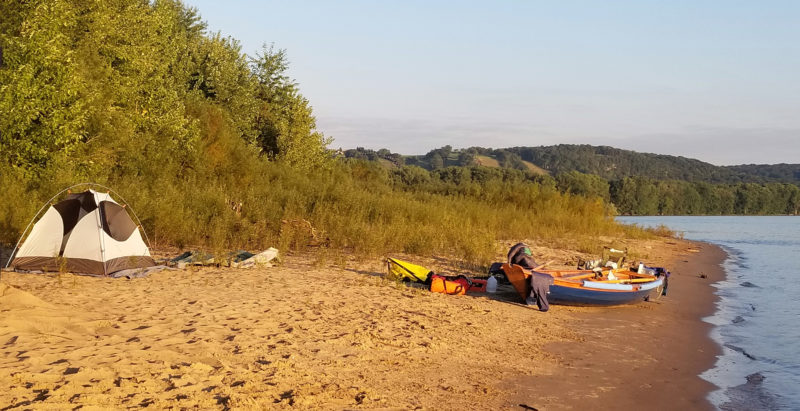
This was the best camping spot in Illinois. I normally didn’t pull LITTLE JOY completely out of the water but the earlier waves forced me too here. My high-class bumpers are made from blue pool noodles.
I hadn’t shaved or washed my clothes for two weeks and could hardly stand up straight as I crossed the paved parking lot to the marina. I must have looked more indigent than adventurous, and I wasn’t surprised when a pickup truck came through a tall chain-link gate and stopped. “Can I help you find something?” said a fit man wearing a golf shirt and neatly groomed hair. “The restaurant?” I said. “Yeah that’s closed. I thought I would save you the trouble,” he told me as he waited for me to leave. I could see that everything was closed up but I stood there for an extra-long moment before turning around and hobbling back.
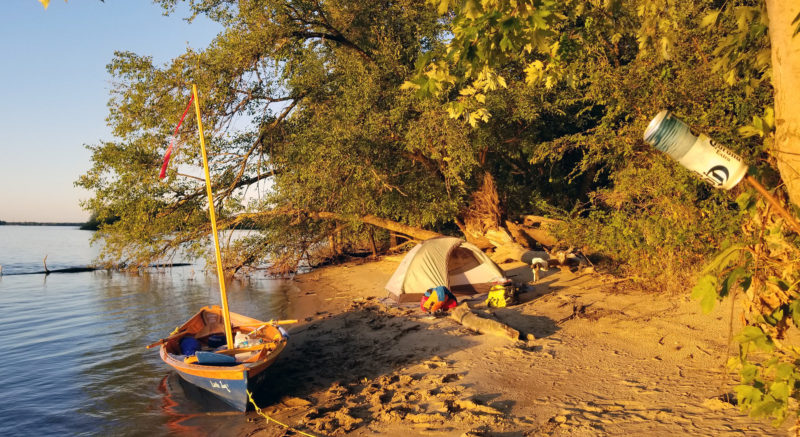
High water sometime made finding a suitable campsite difficult. This narrow beach by the water’s edge ended up being one of my favorites. The beer can and others were left by a previous occupant. Some people just don’t get it. Overall the places where I camped were clean and free of litter.
In the morning, I crawled out of my tent, relieved myself on the marina’s white fence, and as I zipped up I heard over my shoulder, “Hey is that your boat?” I nodded. “You can’t leave it there,” said a man in jeans and a forest-green ranger shirt. I explained that the man from the marina hadn’t been very friendly, and soon the ranger and I were having a friendly conversation about my trip. “That’s a really beautiful boat,” he said, then told me that kayaks and canoes stop here once in a while making the trip but he’s never seen a rowboat here.
He mentioned, more than once, that he thinks about doing a trip like mine, but work and family and…you know. I’d had that longing look before and it always made me grateful I’d had the opportunity. I wondered if the ranger would ever pursue his own adventures.
The first night I spent on a sandbar, I was camped barely 2’ above the water line and hoped the river wouldn’t rise while I slept. Lock and Dam #20 is downstream in the distance.![The first night I spent on a sandbar, I was barely 2’ above the water line and hoped the river wouldn’t rise while I slept. Lock and Dam #20 is downstream in the distance. [between Keokuk and Hannibal]](https://smallboatsmonthly.com/wp-content/uploads/2019/02/MissRiver5957web-800x442.jpg)
Four days out of Winona, I reached Guttenberg, named by the German immigrants who settled there in the 19th century. I opted for a night off the river at a cozy riverfront inn. I had not had a day’s rest since I started two weeks ago, so I stopped in Dubuque and got a hotel room. Two nights on a hotel bed helped my back some, and I was ready to get back on the river. I made my way another 17 miles the next day and spent the night on an Illinois island near Wise Lake. The following day I rowed towards Sabula, Iowa, the only Mississippi River town situated on a mid-river island.
“Where you headed?” asked a shirtless man with a ginger mustache and straw hat. He was at the helm of a well-maintained, well-appointed pontoon boat. Three other people were sitting comfortably under a huge bimini top. I was envious. It had reached 90 degrees Fahrenheit the past three days and the heat was sapping my strength. “Need a place to stay? Maybe a shower?” he asked. Within minutes LITTLE JOY was tied to his boat and I climbed aboard. We made the 5-mile trip downriver past Savanna on the left bank and Sabula on the right to their home.
“Is being towed going to bother you?” The skipper’s wife, Dee, asked as she offered me an ice-cold beer and a soft seat under the shade. “Yes, it will. Very much,” I replied downing the beer. Dave, behind the wheel, said, “It’s all part of the adventure.” He told me that he and his brother canoed the Mississippi a few years back starting in Lake Itasca and ending 800-plus miles later, right back at his home on the river.
The shower, laundry, air conditioning, pizza, beer, and a comfortable bed were small pleasures that I enjoyed all the more for having gone so long without them. While the only offer I took to stay overnight was made by Dave and Dee, there were others who extended invitations. Five third-shift workers from a local Nestle plant arrived at my island beach, their beach, actually, at 7:30 on a Friday morning to throw a Frisbee and have a beer after work. One offered his home to me if I stopped on my way by the next day. Pleasure boaters, townspeople, fellow river travelers offered me water, beer, food, a car ride or even a tow. Many just asked about my general well-being…almost always prefaced by “You’re doing this alone?”
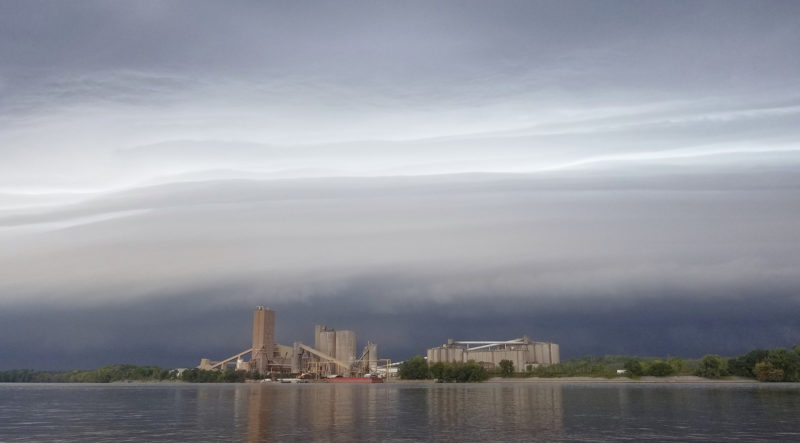
Industrial complexes like this one were a common sight whether for agriculture, coal, stone, etc. Barges are pulled alongside, filled, and then sent down river. I was fascinated by the undulating white clouds being pushed by the coming storm, but not so fascinated by the violent but brief storm they brought. I took shelter on the leeward side of a tiny island.
The days passed and I rowed 25 to 30 miles a day. I passed Davenport without stopping. I passed Muscatine, once the pearl button capital of the world, past Oquawka, Nauvoo, and Keokuk, but stopped for the night in Hannibal, Missouri, to enjoy the hometown of Mark Twain. I had passed through 20 of the 27 locks and accompanying dams of the upper Mississippi. They are part of the 9’ channel project to allow commercial navigation all the way to St. Paul.
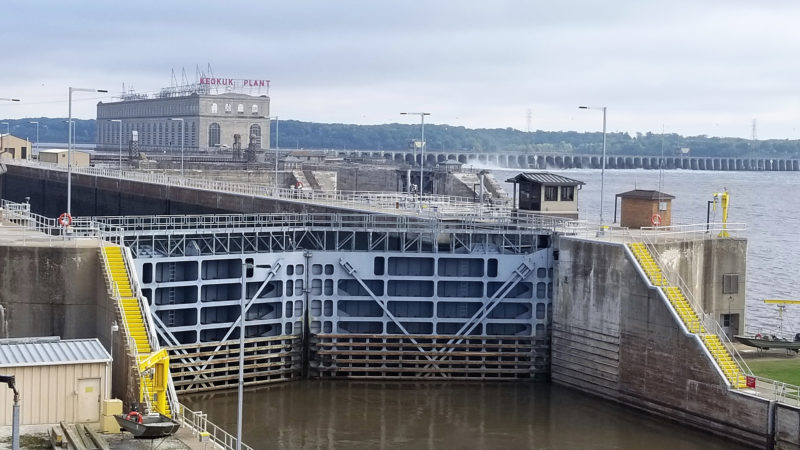
The Lock and Dam #19 at Keokuk is one of three dams that produce electricity. At the time it was built in 1913, its powerhouse was the largest in the world. I stayed well clear of spillway and took the lock; it lowered me 28’, the biggest drop of the trip.
In the morning, I rowed to a mid-river island a few miles downstream from Hannibal. My back was killing me and I couldn’t sit comfortably in the boat. I pulled LITTLE JOY ashore and stretched out on a small sandy beach, warming myself in the sun. My back had been bothering me again for several days, and the miles I had been making were less than I’d hoped for. I began to rethink my plan to reach the Gulf of Mexico.
A towboat chugged by the island pushing a 1,000′ tow. It was only a couple miles to Lock and Dam 22. I knew by the time I got there, the lock would be tied up for a couple of hours as the raft was separated divided into halves and passed through the 600′ lock in two operations. It would be a long wait for my turn.
When I approached the lock, the tow that had passed me was waiting at the entrance; I studied the 3,000′-wide dam, a long, dark line that stretched from the Illinois side out well past the middle of the river. Tight against the Missouri side were the concrete structures of the lock, and between them and the dam was a spillway with 13 bays, each spanned by steel-plate arches above gates that control the flow of the river.
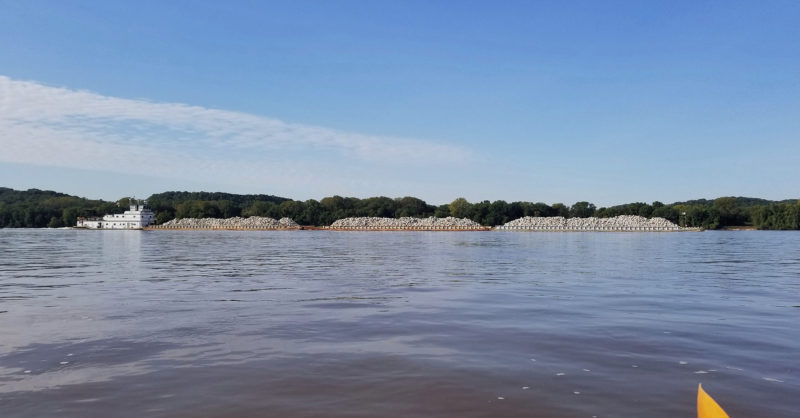
This tow, bound upriver, is pushing a load of rock, probably for a riverside town’s levee.
I lingered above the lock for 20 minutes, but grew tired of waiting. I cinched my PFD and crossed the river upstream from the lock side over to the dam. The water level was high, and I thought I could maybe haul the boat over the dam.
The dam at its lowest point was still showing 2′ above the water, and about 7′ down to the water on the other side. I could not drag the boat over it. I surveyed the spillway. I had rowed LITTLE JOY through two spillways back upstream on the Mississippi, each time knowing it was a stupid idea. The river, a half mile wide above the dam, squeezes through a spillway less than a quarter mile wide, and waves and swirling eddies roar furiously through the gaps. An abandoned barge was wedged cockeyed in one bay, and branches and snags were piled up in others. I took it as a warning and decided to cross back over and just wait my turn at the lock.
I cinched my PFD even tighter and rowed upriver. I managed to travel a few hundred yards, then aimed at a spot just above the lock entrance. The river rushed past and picked up speed as it funneled toward the spillway. I pulled hard, angling the bow upstream. I passed by the openings of the spillway, and when I reached the protection of the lock wall I paused, caught my breath, and called the lockmaster on my VHF radio.
“Lock and Dam No. 22, this is southbound rowboat. I’d like to lock through.”
“Okay skipper, we’ll try to get you through after the southbound tow,” he replied.
When the upstream gates opened for me, I went in. LITTLE JOY floated alone in the middle of the enormous 600′-long, 110′-wide chamber like a toy in a bathtub. Rough, age-worn concrete walls 20′ high and two sets of matching battleship-gray steel gates sealed me in. The water began to drain.
“Hey!” came a voice from atop the wall. “You better have a plan when you leave. There is a 3-by-5 tow waiting to come through.” I had seen the 15-barge raft out in the channel on the downstream side of the dam when I rowed past the spillway crossing to the lock; I wasn’t concerned.
The downstream gates opened, revealing a 15′-high wall of steel blocking my exit—the blunt overhanging bows of the three lead barges. The deckhands on the tow yelled something and laughed. Unsure if the tow was moving, I pulled hard for a small opening between the concrete wall and the steel side of a barge. It was just wide enough for me to pass through.
I shot out into the churning water below the spillway. The towboat fired up its engines and began to move into the lock. I caught my breath, laughed with relief, and let the current carry me. The river, again half a mile wide, swirled lazily. Low, green, tree-covered bluffs ran along both shores. A bald eagle soared low along the treetops. There was not another boat in sight; astern, the dam slowly disappeared behind a bend in the river.
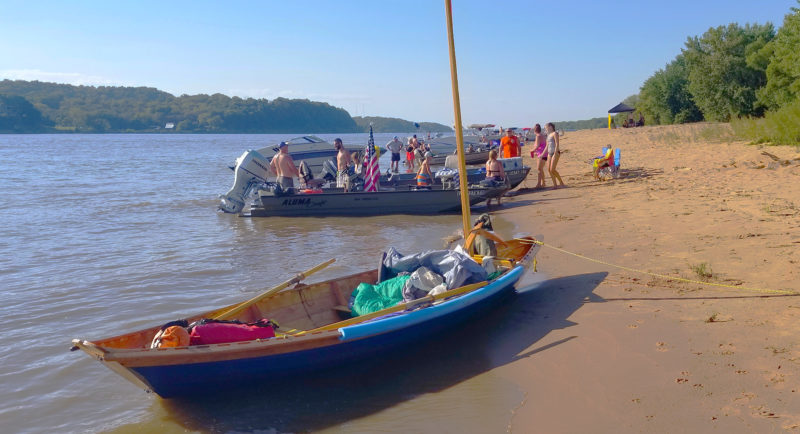
One of the largest beaches I saw in Illinois stretched several hundred yards with almost every foot of shoreline occupied on a beautiful Sunday afternoon. The question most often asked here was: “Hey, doesn’t that have a motor?”
A few miles more downriver I heard the growl of outboard engines. It was a sunny, hot Sunday in late September and weekenders were back out. I had reached St. Louis’s sphere of affluence. I had also reached a decision. I would stop in St. Louis and the end of the trip. My back pain was unbearable and I feared the lower Mississippi would prove to be even harder going.
I stopped in the late afternoon at large sand bar where other boaters were set up for a day on the beach. As the sun neared the western riverbank, they began to leave to make their way back to their marinas. As I set up camp, one of the last of the boaters, a woman in a one-piece bathing suit, came over. She was followed by three men with round bellies and a touch of sunburn. We had the usual conversation, they admired my boat, which made me stand a little straighter, then offered me a big bag of ice, a luxury I gratefully accepted.
“Do you have an anchor?” one guy asked.
“Nope. I’ll just pull it up.”
“Better anchor it. A barge will come by and wash it away.”
“Hope the critters won’t get you.”
“You know, if you set up over there, nobody will mess with you.”
I smiled. “Nah. Nobody will mess with me.” I was hairy and shaggy, dirty and smelly, hungry and lean. Nah, nobody would mess with me.
The marina at Alton, Illinois, is just upriver from St. Louis. The last lock and dam on the river, 1.5 miles downstream, was in view and another 5 miles from the lock, around the next bend was the confluence with the great Missouri River. The marina was full of fancy sail and power boats. The harbormaster gave me a small space for a large fee so I could leave LITTLE JOY for three days and a well-deserved rest, while I retrieved my truck and trailer from Minneapolis. Before heading to the airport, I walked along the St. Louis riverfront where the Gateway Arch, the symbol of St. Louis, stood glistening in the light of the setting sun. I climbed up to the walkway of the Eads Bridge, the same bridge that I crossed two summers ago on a cross-country bicycle ride. The same place where I saw the Mississippi for the first time. I walked out to the middle of the bridge. The river stretched south in a long, wide ribbon and glistened in the setting sun. I looked down. The river was no longer green, but brown with Missouri River mud and swirling around the gray stone pier below. Now doubled in volume, the Mississippi River from there flows unimpeded by dams for 1,200 miles to the Gulf of Mexico.
As cars flashed by on the other side of a low cement barrier just a few feet away from me, I raised my arms and let out a yell, “Yeahhh!” I did not complete what I set out to do, but I covered 650 river miles in 30 days. It was more than enough; I could go home.![]()
Part 2 of this adventure appears in the June 2020 issue.
David Hudson is a happy corporate refugee. As a teenager, he spent countless summer days rowing a 10′ aluminum pram around a small New Jersey lake. Later he cruised the Atlantic and Mediterranean atop the deck of a U.S. Naval helicopter carrier. Downsizing since the Navy, he has spent time exploring the rivers and lakes of New Jersey, New York and Ontario in a canoe. Putting his woodworking skills to a test, he built his 17′ dory, LITTLE JOY, and can be found, along with his wife Xiaole, rowing it up and down the Schuylkill River outside of Philadelphia.
If you have an interesting story to tell about your adventures with a small boat, please email us a brief outline and a few photos.




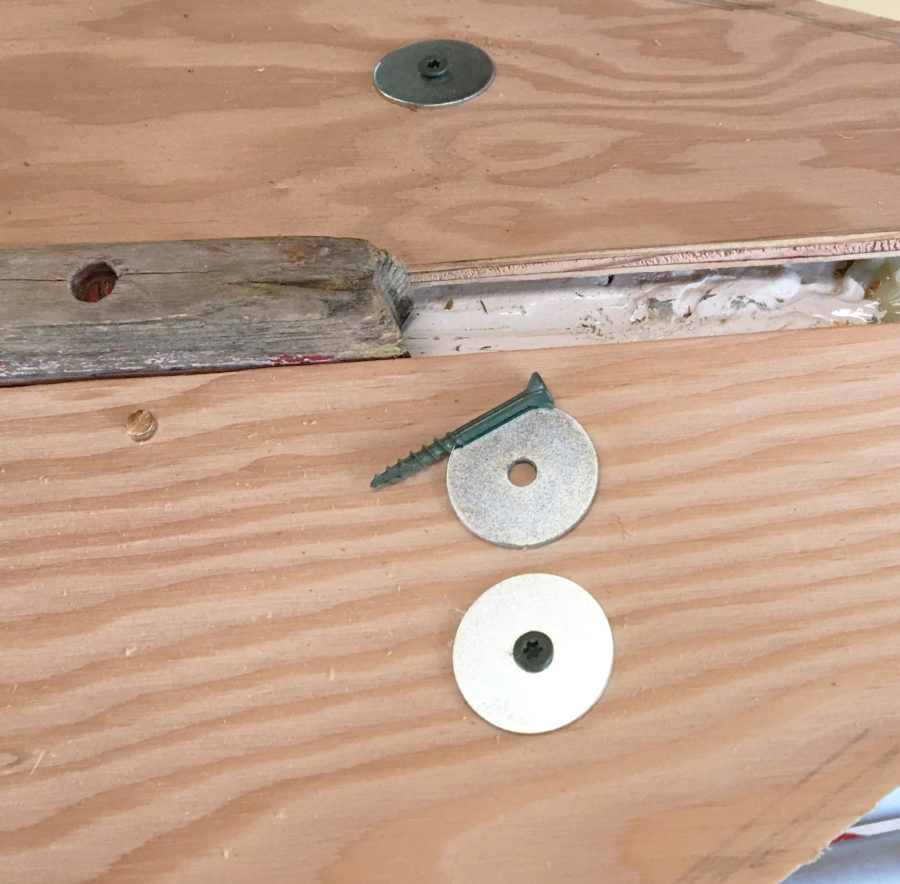
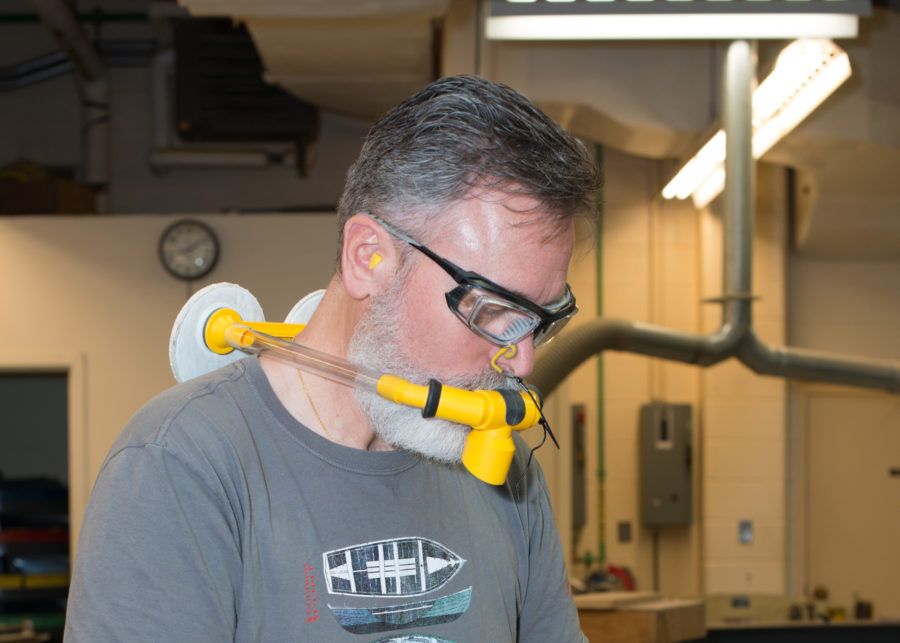
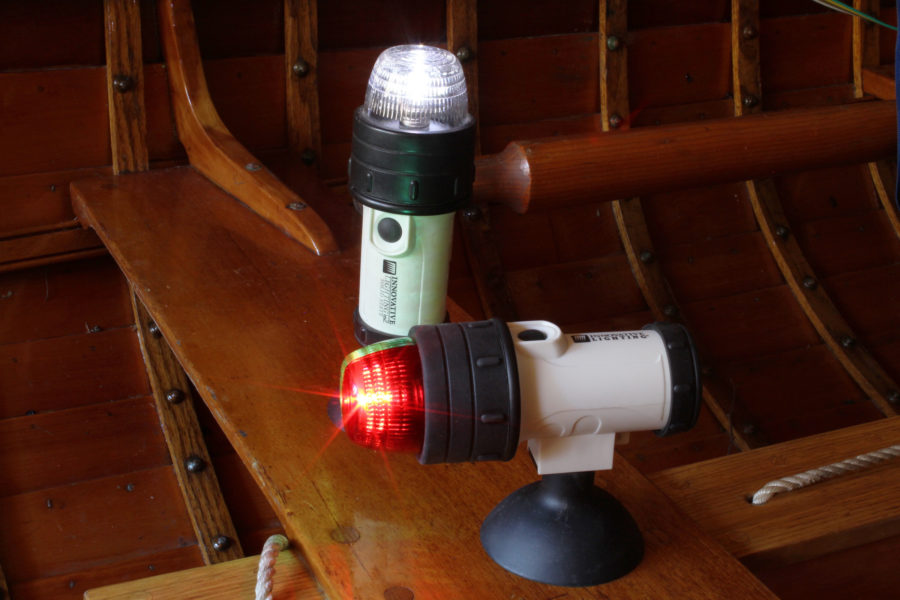
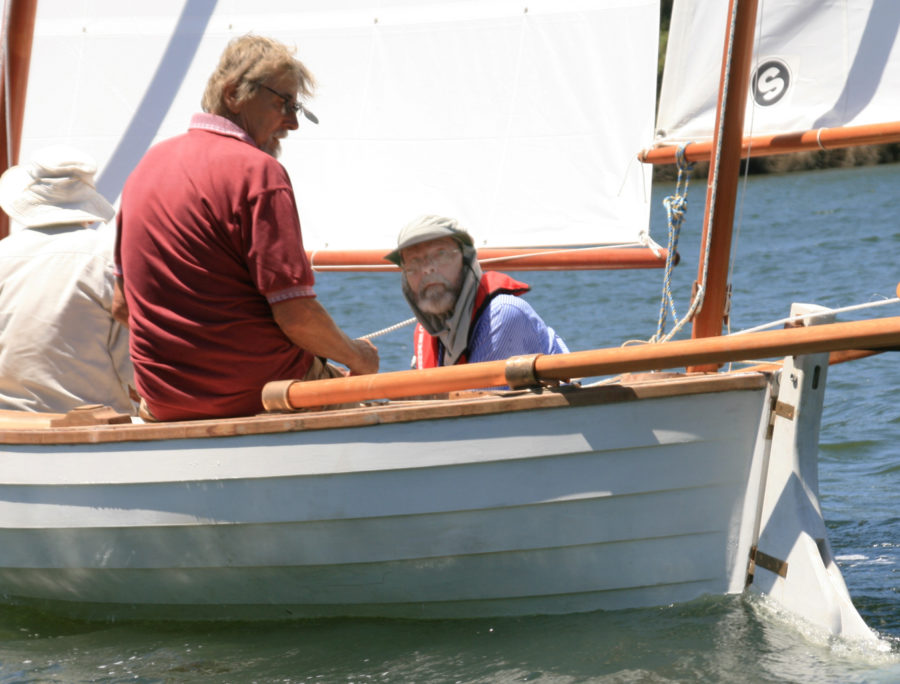
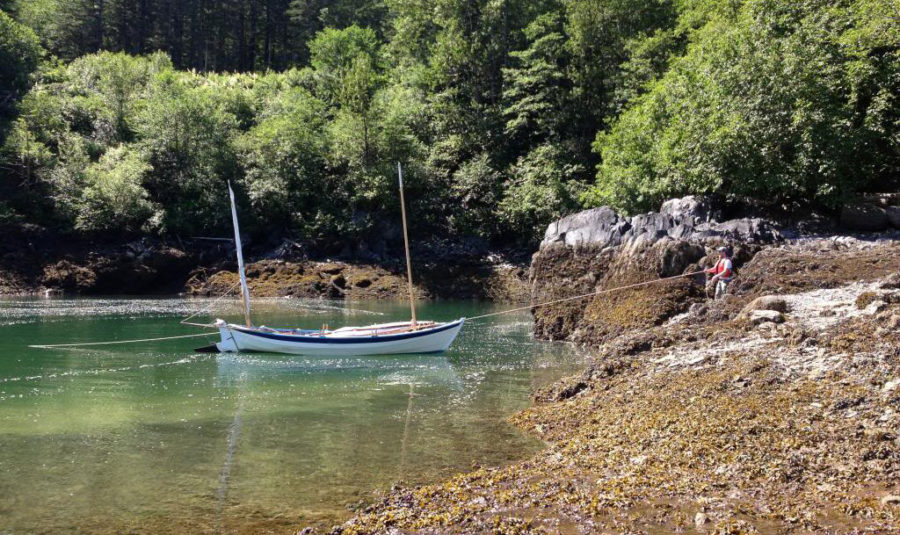
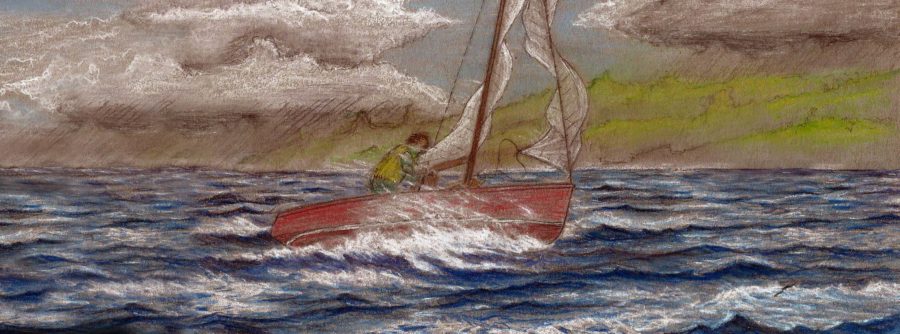
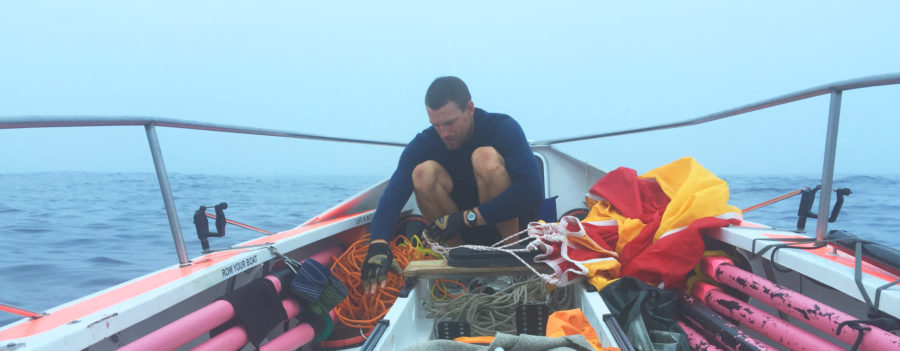
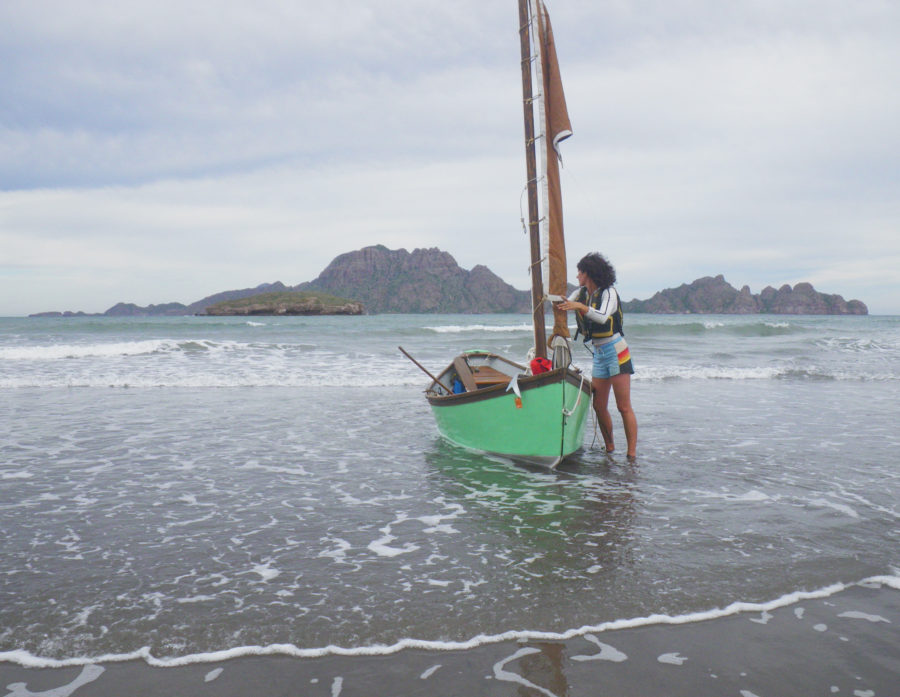
Very enjoyable to this home-bound past skipper. Thanks for sharing.
LITTLE JOY is a Chesapeake Light Craft Northeaster Dory. We reviewed the Northeaster in our print annual, Small Boats 2011. Kits and plans are available from Chesapeake Light Craft.
—Ed.
LITTLE JOY is a beautiful boat and appears well built. I am curious about its design and would like to know if plans are available.
Thanks for sharing your story, David.
What a pleasurable story to read. Thank you for sharing your adventure
George
Great story! Thanks for sharing it! I will steal your pool-noodle gunwale bumper idea! LOL,cheap,easy to replace. Thanks
Great story! Thanks for sharing.
More proof, if proof were needed, that the quest for adventure needn’t be constrained by age or budget.
I really enjoyed this story. It reminded me of my youth growing up in Pittsburgh, PA, a city that is where it is because of the large rivers that meet there. As a young man, we used to paddle and row our canoes and boats amidst the considerable commercial traffic that passed through town, day and night. Though the tows posed a very real danger they could also provide a heightened level of sport. If you caught their bow or stern waves just right it was possible to “surf” both upstream and down. Chosen carefully, and undertaken with caution, I think riverine cruises can be among most interesting and rewarding adventures to be experienced, in a wide variety of small craft.
Fun article. I enjoyed reading it. What a fun journey Xiao le!
Maggie
David, I notice in some pics you’re anchored with the mast up, and in others the mast is down. Any reason why? Were there many bridges where, to go under, you had to remove the mast? One last question – along the Schuylkill is there some point upwards from Philadelphia, where the current downstream is too strong to row upstream – I’d be in a Skerry, similar to your NE Dory but a bit smaller. Thanks for both your Downriver articles!
Brad